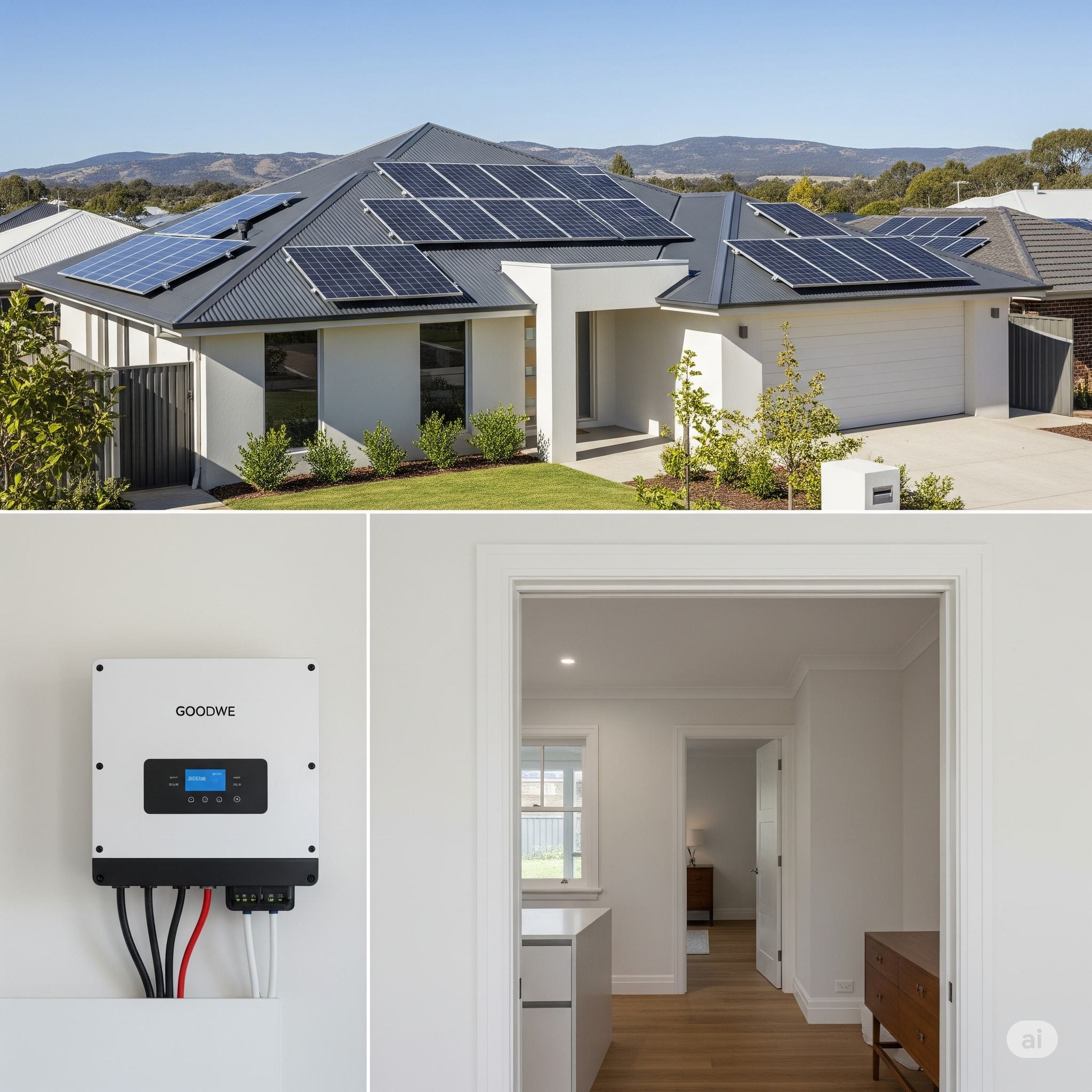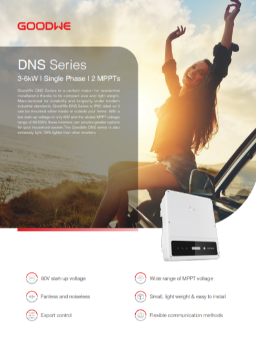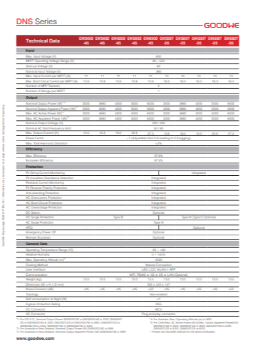Get an in-depth Goodwe inverter review for 2025 from an Australian solar expert. Explore models, features, reliability, warranty, and why Goodwe is a popular choice for cost-effective, high-performing solar systems.
As a seasoned solar system installer here in Australia, I've seen countless inverters come and go. But one brand that consistently captures the attention of homeowners and installers alike is Goodwe. In 2025, Goodwe continues to be a major player in the Australian solar market, known for offering a compelling blend of affordability, reliability, and increasingly, advanced features.
Get a quick free quote
Under no obligation
This comprehensive Goodwe inverter review for 2025 will provide you with all the insights you need to make an informed decision for your Australian home. We'll delve into their latest models, technical specifications, real-world performance, and compare them against other prominent brands.
Introduction: The Goodwe Promise in 2025
Goodwe has solidified its position as a go-to choice for cost-effective and dependable solar inverter solutions in Australia. Since its inception in 2010, the company has consistently innovated, offering products that cater to a wide range of residential and commercial needs. In 2025, Goodwe continues to impress with its focus on smart energy management, enhanced safety features, and a commitment to making solar energy accessible. This Goodwe inverter review aims to cut through the noise and provide an honest assessment from an installer's perspective.

Who is Goodwe? A Company Overview
Goodwe Power Supply Technology Co. Ltd. is a global leader in solar inverter manufacturing, with a significant presence in over 100 countries, including a strong foothold in Australia. Founded in Suzhou, China, Goodwe has grown rapidly, boasting a large workforce dedicated to research and development. Their commitment to innovation and quality has earned them a strong reputation for delivering efficient, safe, and durable solar energy solutions. Their recent inclusion as a BloombergNEF Tier 1 Power Inverter Manufacturer for Q2 2025 further highlights their strong bankability and reliability in the global market.
Goodwe's Product Range 2025: What's on Offer?
In 2025, Goodwe offers a diverse portfolio of inverters designed for various applications, from small residential systems to large commercial installations. Their key series for residential and commercial applications include:
Residential Grid-Tied Inverters:
DNS G4 (3-6kW): Known for reduced weight and noise, supporting parallel connection.
MS G4 (7.5-10kW): Similar benefits to the DNS G4, catering to larger residential systems.
XS Series: Compact and efficient, ideal for smaller residential systems.
Hybrid Inverters (Battery-Ready):
EH Plus Series: Single-phase hybrid inverters with advanced features for residential energy storage integration. These are upgradable, allowing you to add battery functionality later.
ET G2 (3-phase, 6-20kW) & ET series (40-50kW, 75-100kW): High-voltage, three-phase hybrid inverters suitable for larger homes and commercial applications, offering powerful backup functionality.
ESA Series (Residential & C&I): New all-in-one solutions, with advanced 6-layer safety protection and compatibility with AI Energy Management Systems.
Commercial & Industrial (C&I) Inverters:
SDT G3 (4-20kW & 50kW): High-power input, increased yield, and smart-grid ready.
GT Series (100kW, 125kW, 150kW): Designed for larger-scale string inverter applications.
Goodwe's emphasis in 2025 is clearly on integrated systems, energy storage, and smart energy management.
Key Features and Technologies in Goodwe Inverters (2025)
Goodwe inverters in 2025 are packed with features aimed at maximizing efficiency, safety, and user convenience. Here are some notable technologies:
Multiple MPPT Channels: Many Goodwe models, including the popular DNS and MS series, feature multiple Maximum Power Point Trackers (MPPTs). This is crucial for Australian homes with multiple roof orientations or shading, as it optimizes power harvesting from each string of panels independently.
Low Start-Up Voltage: Goodwe inverters boast low start-up voltages (often around 80V DC or even 40V DC for residential models). This means they can begin generating power earlier in the morning and continue later in the evening, extending your solar production window.
High Efficiency: Goodwe inverters consistently achieve high efficiency ratings, typically around 97.7% to 98.6%. This translates to more of your generated DC power being converted into usable AC electricity for your home.
Integrated Wi-Fi Monitoring (SEMS Portal): Most Goodwe inverters come with built-in Wi-Fi, allowing for easy monitoring of your system's performance via their SEMS Portal app.
Smart Energy Management System (EMS): Goodwe is heavily investing in EMS integration, allowing for optimized energy consumption, storage, and even participation in Virtual Power Plants (VPPs) for certain models.
Advanced Safety Features: In 2025, Goodwe is prioritizing safety with features like AI-driven Arc Fault Circuit Interruption (AFCI) 3.0 and Rapid Shutdown (RSD) 2.0, providing enhanced protection against electrical hazards.
Battery Compatibility: Goodwe excels in hybrid solutions, offering seamless integration with various battery types, particularly their own Lynx Home U and Lynx Home F series.
Below is the official datasheet:


Performance and Efficiency: How Goodwe Stacks Up
From an installer's perspective, Goodwe inverters consistently deliver reliable performance. Their high efficiency ratings mean minimal energy loss during the DC-to-AC conversion process. In real-world Australian conditions, their ability to handle varying temperatures and light conditions is commendable. The multiple MPPTs are particularly beneficial for maximizing yield from complex roof layouts. While some premium brands might offer a fractional percentage point higher efficiency, the cost-effectiveness of Goodwe often makes their overall energy yield highly attractive.
Reliability and Durability: Built for Australian Conditions
Goodwe has a strong reputation for building robust and durable inverters that can withstand the demanding Australian climate, including high temperatures and dust. Their products undergo rigorous testing and comply with international standards. The fact that they have been operating in the Australian market for over 12 years and are a BloombergNEF Tier 1 manufacturer speaks volumes about their reliability and commitment to long-term performance. While no electronic device is infallible, Goodwe's failure rates are generally low, and their build quality is considered solid for their price point.
Warranty and After-Sales Support in Australia (2025)
Goodwe typically offers a standard 5-year warranty on many of its inverter models, with options for extensions up to 10 years, particularly when paired with their compatible battery storage solutions (e.g., Lynx Home U or Lynx Home F batteries installed between specific dates and connected to the SEMS+ APP). It's crucial to register your inverter and batteries to activate these extended warranties.
Goodwe has established a support network in Australia. While some users in the past have reported slower response times compared to premium brands, Goodwe has been actively working to improve its local customer service and technical support. Many experienced installers, like myself, have direct channels for support, which often streamlines troubleshooting.
Goodwe Inverter Price Range (Australia 2025)
One of Goodwe's most significant advantages is its competitive pricing. They generally offer more budget-friendly options compared to premium European brands like Fronius, while still delivering excellent quality and reliability.
As an example, for a 10kW single-phase inverter, a Goodwe GW10K-MS-30 might come in around AUD $1,300, whereas a premium alternative like a Fronius Gen24 10.0 Primo could be upwards of AUD $3,700. This substantial price difference can make Goodwe a very attractive proposition for homeowners looking to invest in solar without a massive upfront cost. Hybrid inverters will naturally be more expensive due to their battery-ready capabilities.
Goodwe vs. Fronius (2025 Comparison for Australia)
When considering a Goodwe inverter review, a common comparison is with Fronius, a highly respected premium European brand.
Cost: Goodwe is significantly more affordable.
Efficiency & Performance: Both offer high efficiency. Fronius might have a slight edge in some advanced features and potentially higher peak performance in specific scenarios. Goodwe's multiple MPPTs make it very competitive for complex installations.
Reliability & Durability: Both are considered highly reliable. Fronius has a legendary reputation for robust build and longevity, though some recent customer feedback indicates potential warranty challenges. Goodwe is proving its long-term durability, especially with its Tier 1 status.
Features: Both offer smart monitoring. Fronius often provides more in-depth data and advanced grid interaction features. Goodwe is rapidly catching up, especially in integrated energy management and safety.
Warranty & Support: Fronius typically offers a strong 10-year standard warranty. Goodwe offers 5 years standard with promotional 10-year extensions when paired with their batteries. Fronius's support has traditionally been excellent, though recent feedback suggests some challenges. Goodwe's support network is improving in Australia.
Verdict: For homeowners on a tighter budget who still want a reliable, high-performing inverter, Goodwe offers exceptional value. For those prioritizing absolute top-tier features and are willing to pay a premium, Fronius remains a strong contender.
Goodwe vs. Sungrow (2025 Comparison for Australia)
Another frequent comparison in a Goodwe inverter review is with Sungrow, another leading Chinese manufacturer.
Cost: Goodwe is often slightly more budget-friendly than Sungrow.
Efficiency & Performance: Sungrow often has a marginal lead in peak efficiency (e.g., 98.7% vs. Goodwe's 98.3%), which can translate to slightly higher energy yield over time. Both perform very well in Australian conditions.
Reliability & Durability: Both are known for their reliability. Sungrow has a strong reputation for durability, particularly in larger-scale installations. Goodwe is highly reliable, especially with its Tier 1 status.
Features: Both offer integrated monitoring apps. Sungrow's iSolarCloud app often provides more detailed insights for users who want in-depth monitoring. Goodwe excels in integrated energy management and its focus on safety features.
Warranty & Support: Sungrow often provides a standard 10-year warranty. Goodwe has a 5-year standard with optional 10-year extensions with battery pairing. Both have good support networks in Australia.
Verdict: Both Goodwe and Sungrow offer excellent value. Goodwe is often preferred for its cost-effectiveness and strong focus on hybrid systems and smart energy management. Sungrow might appeal to those seeking a slightly higher efficiency edge and more detailed monitoring data.
Common Goodwe Inverter Issues and Troubleshooting (2025)
While Goodwe inverters are generally reliable, like any electronic device, they can encounter issues. Here are some common concerns and initial troubleshooting steps:
"Waiting" or No Production: This often means the inverter is waiting for sufficient DC voltage to start operating (e.g., early morning, low light). If it persists during peak sun, check DC isolator is on.
Error Codes: Goodwe inverters display error codes (e.g., "Inverter failure," "System failure"). Short-pressing the button several times can access the "Error Code History" menu. Common codes include:
SPI Failure (#1), Memory Chip Failure (#2): Often resolved with a restart.
FAC Failure (#3): Grid frequency out of range, usually self-corrects as the inverter restarts.
Ground Insulation Impedance Low (#14): Requires professional inspection of earthing.
Fan Issues (#16, #20): Can sometimes be resolved by clearing debris or a restart.
High Input Voltage (#17), High DC Bus Voltage (#21): Turn DC switch off and on. If persistent, requires professional intervention.
Overheating (#18): Check for clear ventilation around the inverter.
Wi-Fi Connectivity Issues: Ensure the Wi-Fi antenna is correctly installed, the inverter is powered, and the POWER LED is blinking. Reloading Wi-Fi as per the manual can help.
Goodwe Inverter Offline: This usually points to a communication issue. Check your internet connection and the inverter's Wi-Fi status.
Important Note: For persistent issues or any safety concerns, always contact a qualified solar technician or your installer. Do not attempt complex repairs yourself.
Monitoring Your Goodwe System with SEMS Portal
Goodwe's SEMS Portal is a user-friendly app and web platform that allows you to monitor your solar system's performance in real-time. Key features include:
Real-time Data: View your current power generation, consumption, and battery status (for hybrid systems).
Historical Data: Track daily, monthly, and annual energy production and consumption.
Performance Analysis: Identify trends, optimize self-consumption, and detect any potential issues.
Alerts and Notifications: Receive instant alerts for system faults or anomalies.
Remote Control: Some advanced features allow for remote configuration or firmware updates.
The SEMS Portal is a valuable tool for maximizing your solar investment and ensuring your system is operating optimally.
Goodwe Hybrid Inverters and Battery Storage
Goodwe has been a pioneer in battery-capable inverters, and their hybrid solutions are a major drawcard. Their EH Plus (single-phase) and ET (three-phase) series are designed to seamlessly integrate with battery storage, offering:
Increased Self-Consumption: Store excess solar energy during the day to use at night or during peak tariff periods.
Backup Power: Provide power to essential circuits during grid outages (with compatible battery and setup).
Energy Independence: Reduce reliance on the grid and gain greater control over your energy usage.
Future-Proofing: Easily add battery storage at a later date, thanks to their "battery crippled" models that can be unlocked.
Their own Lynx Home U and Lynx Home F batteries are specifically designed to work optimally with Goodwe inverters.
Installation Considerations for Goodwe Inverters
As an installer, I appreciate Goodwe's ease of installation. Their compact design and clear instructions generally make the process straightforward. Key considerations for optimal installation include:
Location: Install in a cool, well-ventilated area, out of direct sunlight. While some models are IP65 rated for outdoor use, shade is always preferred for longevity.
Proximity to Panels: While Goodwe has multiple MPPTs, minimizing DC cable runs is always good practice.
Proper Earthing: Crucial for safety and system performance.
Wi-Fi Signal: Ensure a strong Wi-Fi signal for reliable monitoring.
Professional Installation: Always use a CEC-accredited installer in Australia to ensure compliance with standards and maximize efficiency and safety.
Are Goodwe Inverters Right for Your Australian Home in 2025?
Goodwe inverters are an excellent choice for a wide range of Australian homeowners, particularly those who:
Are Budget-Conscious: They offer a fantastic performance-to-price ratio.
Want Reliability: Goodwe is a proven, reliable brand with a strong track record.
Are Planning for Battery Storage: Their hybrid inverters are highly compatible and offer seamless integration.
Have Complex Roof Orientations: Multiple MPPTs effectively handle shading and varying panel angles.
Value Smart Monitoring: The SEMS Portal provides comprehensive insights into system performance.
The Future of Goodwe: 2025 and Beyond
Goodwe is clearly focused on the future of solar energy, with a strong emphasis on:
Integrated Solutions: Combining PV, storage, EV charging, and smart home systems.
AI-Driven Management: Utilizing AI for optimized energy flow, predictive maintenance, and enhanced safety (e.g., AFCI 3.0).
Higher Power Density: Developing more compact yet powerful inverters.
Global Expansion: Continuing to strengthen their presence and support networks worldwide.
Their recent product releases and strategic partnerships at industry events like Intersolar 2025 and SNEC 2025 demonstrate their commitment to staying at the forefront of solar technology.
Actionable Tips for Maximizing Your Goodwe Inverter's Performance
Regular Monitoring: Check your SEMS Portal regularly to identify any performance drops or errors.
Keep Vents Clear: Ensure the inverter's ventilation isn't obstructed by dust or debris to prevent overheating.
Clean Solar Panels: Dirty panels reduce production, which impacts your inverter's output.
Understand Your Usage: Use the SEMS Portal data to adjust your energy consumption habits and maximize self-consumption, especially with a hybrid system.
Schedule Professional Maintenance: Annual or bi-annual checks by a qualified technician can extend the life of your inverter and entire solar system.
Frequently Asked Questions (FAQs) about Goodwe Inverters
Q1: How long do Goodwe inverters typically last? A1: Goodwe inverters are designed for longevity, typically lasting 10-15 years or more, often aligning with their warranty periods. Proper installation and maintenance contribute significantly to their lifespan.
Q2: Is Goodwe a Tier 1 inverter brand? A2: Yes, Goodwe has been consistently named a Tier 1 Power Inverter Manufacturer by BloombergNEF, indicating their strong bankability and reliability in the industry.
Q3: Can I add a battery to my Goodwe inverter later? A3: Yes, many Goodwe grid-tied inverters (e.g., EH Plus series) are "battery-ready" or can be easily upgraded to hybrid functionality with an unlock code, allowing you to add battery storage when you're ready.
Q4: What is the SEMS Portal? A4: SEMS Portal is Goodwe's online monitoring platform (accessible via app and web) that allows you to track your solar system's real-time and historical performance, energy consumption, and receive alerts.
Q5: Are Goodwe inverters good for shaded roofs? A5: Goodwe inverters with multiple MPPTs are well-suited for roofs with partial shading or multiple orientations, as each MPPT optimizes the power from different strings of panels independently. However, for severe or persistent shading on individual panels, micro-inverters or optimizers might offer marginally better performance, but often at a higher cost.
Conclusion: Goodwe Inverter - A Smart Choice for 2025
In conclusion, for Australian homeowners considering solar in 2025, the Goodwe inverter review strongly positions it as an outstanding value proposition. Goodwe consistently delivers reliable, efficient, and increasingly smart inverters that perform exceptionally well in our unique climate. Their commitment to integrated solutions, safety, and competitive pricing makes them a formidable choice, especially for those looking to embrace battery storage now or in the future. While premium brands exist, Goodwe strikes an impressive balance between cost and performance, making sustainable energy more accessible without compromising on quality.
Ready to Go Solar with a Goodwe Inverter?
Choosing the right inverter is a critical step in your solar journey. If this Goodwe inverter review has sparked your interest, or if you have more questions about which Goodwe model is best suited for your specific needs and budget, don't hesitate to reach out!
Call us today for a no-obligation quote and a personalized assessment of your solar energy requirements! Let's power your home with clean, efficient solar energy.